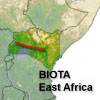 



Weather data
A large number of automatic weather stations has been implemented in the frame of the BIOTA AFRICA project by the Namibian National Botanical Research Institute (NBRI) and the Group "Biodiversity, Evolution and Ecology" (BEE) of the University of Hamburg. The website offers hourly updates of data and graphs of a large number of weather parameters.

|
 BIOTA East Africa - Workpackage(s)
BIOTA East Africa - Workpackage(s)
Subproject |
E03 - Regeneration of tropical trees - implications for forest conservation |
Workpackage |
WP1: Experiments on germination and seedling establishment and application in the KEEP Tree Nursery |
Project leader(s) |
Dipl.-Biol. Robert Gliniars
Dr. Mathias Oesker |
Project description |
The main aim of this work package will be to identify tree species that can be used for restoration of degraded sites in Kakamega and Budongo Forests and for gaining knowledge on seedlings that can be used by the local communities and the KEEP tree nursery. Historical accounts reveal that Kakamega Forest and Budongo Forest have suffered from a high human impact leading to a large reduction in forest cover, which has resulted in a loss of species and biodiversity.
Germination and seedling establishment are the most crucial stages in development of tree species. Tree diversity has been shown to influence the heterogeneity of abiotic variables, and this in turn has an effect on the establishment of seedlings.
Effect of abiotic factors such as light, nutrients, and water on seedling establishment will be investigated. Experiments will be conducted in the existing greenhouse and adjacent farmlands. Germination rates, mortality rates and requirements for germination will be assessed.
Selection of experimental indigenous tree species will be based on growth performance, the economic and environmental benefits, the seed availability, the information on silvicultural characteristics and management of those species growth rates (fast-growing trees like Polyscias fulva and Croton megalocarpus), timber species like Milicia excelsa and threatened tree species such as the mahogany (Entandrophragma spp.) and in close cooperation with E15b which uses around 50 tree species as target species for mapping approaches. Criteria for selection of priority species for restoration will be based on germination rates, growth rates and plants that can survive in adverse environmental conditions.
The overall aim in the third phase will be to train the KEEP nursery members so that at the end of BIOTA East the nursery is self-sustainable with the knowledge of a variety of tree species on offer and a well-organized management with cooperation partners KWS and KEFRI.
KWS continues to support these activities and had recently allowed the construction of a borehole to install a well to have enough water supply during the dry season. |
Keywords |
germination, seedling establishment, Tree Nursery, indigenous tree species, tree development |
Contribution to
cross-cutting themes (CCT) |
- Understanding natural processes of change (Theme2)
- Recommendations and measures for sustainable use of biodiversity (Theme4)
|
Link to Subproject |
E04
E14 E15b
|
|
|






 Go to the WeatherNet
Go to the WeatherNet BIOTA East Africa - Workpackage(s)
BIOTA East Africa - Workpackage(s)